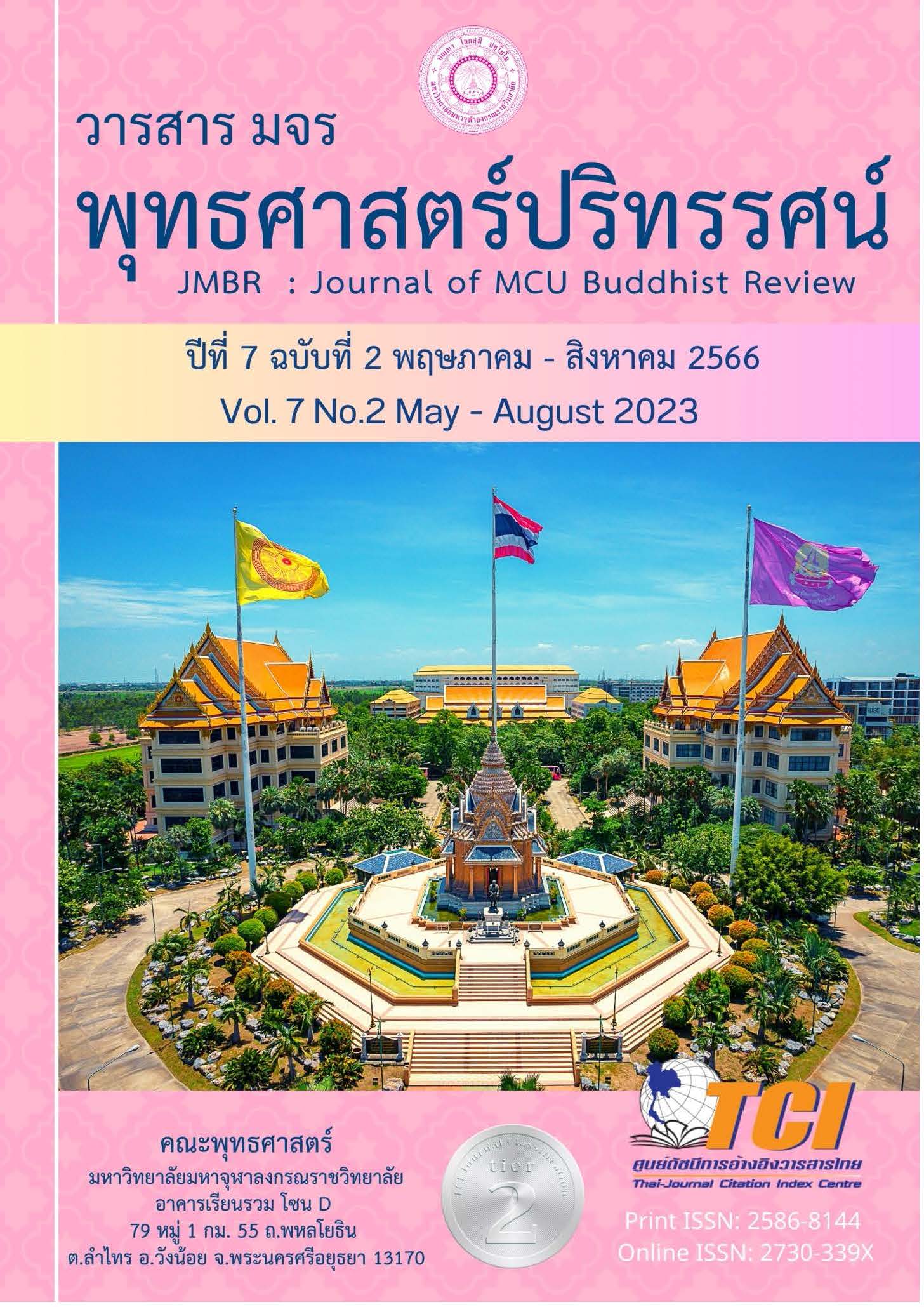ศึกษาวิเคราะห์ข้อปฏิบัติของพระเสขะในเสขปฏิปทาสูตร
Main Article Content
บทคัดย่อ
บทความวิจัยนี้มีวัตถุประสงค์ 1) เพื่อศึกษาโครงสร้างและสาระสำคัญของเสขปฏิปทาสูตร 2) เพื่อศึกษาข้อปฏิบัติตามแนวของพระเสขะที่ปรากฏในพระไตรปิฎก 3) เพื่อวิเคราะห์ข้อปฏิบัติของพระเสขะที่ปรากฏใน เสขปฏิปทาสูตร เป็นการวิจัยเชิงเอกสาร ที่ผู้วิจัยได้ทำการศึกษาค้นคว้าจากแหล่งข้อมูล คือ พระไตรปิฎก อรรถกถา หนังสือและงานวิทยานิพนธ์ที่มีความเกี่ยวข้องกับพระสูตรนี้ เพื่อนำใช้ประกอบการอธิบายในงานวิจัยนี้ให้ชัดเจนเพียงพอ
ผลการวิจัยพบว่า 1) เสขปฏิปทาสูตรนี้ เป็นพระสูตรที่อยู่ในพระสุตตันตปิฎก มัชฌิมนิกาย มัชฌิมปัณณาสก์ ที่มี 5 วรรค และจัดอยู่ในวรรคที่ 1 คือ คหปติวรรค มี 10 สูตร เสขปฏิปทาเป็นสูตรที่ 3 ของวรรคนี้ ว่าด้วยข้อปฏิบัติของพระเสขะ ที่พระพุทธเจ้ารับสั่งให้พระอานนท์เป็นผู้แสดงให้แก่พวกเจ้าศากยะ ที่หวังความเจริญและเป็นมงคลแก่ท้องพระโรงหลังใหม่ 2) ข้อปฏิบัติของตามแนวพระเสขะปรากฏในพระไตรปิฎก
ที่เป็นหลักสำคัญมีอยู่ 4 หมวด คือ 1. สีลสัมปทา 2. อปัณณกปฏิปทา 3 3. สัทธรรม 7 ประการ 4. ฌาน
3) ข้อปฏิบัติของพระเสขะในปฏิปทาสูตรนี้ เรียกอีกอย่างว่า จรณะ 15 คือ ธรรมสำหรับประพฤติ พระเสขะ คือ ผู้ที่ยังต้องศึกษาในไตรสิกขา ได้แก่ ศีล สมาธิ ปัญญา ซึ่งถือได้ว่าเป็นแนวทางการศึกษาอีกแนวหนึ่งในทางพระพุทธศาสนา อีกประการหนึ่ง จรณะ 15 หากประพฤติปฏิบัติได้ถึงพร้อมบริบูรณ์ ทำให้มรรคมีองค์ 8 เกิดขึ้นครบทุกองค์มรรค อันเป็นทางดำเนินสู่การบรรลุมรรค ผล นิพพาน ที่เรียกว่า ทางสายกลาง หรือมัชฌิมาปฏิปทา
เสขะปฏิปทาสูตรนี้ เป็นพระสูตรที่บรรพชิตผู้หวังความเจริญในพระพุทธศาสนา พึงนำไปปฏิบัติให้ถึงพร้อมตั้งแต่ขั้นศีล ตามหลักการของจรณะ 15 เพื่อเจริญรอยตามพระอริยบุคคล แม้ยังมิได้ถึงขั้นโลกุตตระ เพียงแค่เป็นผู้ตั้งอยู่ในโสดาปัตติมรรค และผล ก็ถือได้ว่าเป้นผู้เข้าสู่กระแสพระนิพพานในกาลข้างหน้า แม้คฤหัสถ์หากเคร่งครัดในศีล 5 หรือศีล 8 ก็สามารถบรรลุมรรค ผลได้ ตามนัยเดียวกันกับบรรพชิต หรือเพียงแต่นำมาประยุกต์ใช้กับชีวิตประจำวัน ก็จะได้แต่สิ่งที่เป็นมงคลและความเจริญแก่เราได้ในชาติปัจจุบัน
Article Details

อนุญาตภายใต้เงื่อนไข Creative Commons Attribution-NonCommercial-NoDerivatives 4.0 International License.
- บทความที่ได้รับการตีพิมพ์เป็นลิขสิทธิ์ของวารสาร มจร พุทธศาสตร์ปริทรรศน์
- ข้อความใดๆ ที่ปรากฎในบทความที่ได้รับการตีพิมพ์ในวารสาร ถือเป็นความรับผิดชอบของผู้เขียนบทความ และข้อคิดเห็นนั้นไม่ถือว่าเป็นทัศนะและความรับผิดชอบของกองบรรณาธิการวารสาร มจร พุทธศาสตร์ปริทรรศน์
เอกสารอ้างอิง
พระครูสิริปริยัติโกศล (กุมพล). (2564). การศึกษาวิเคราะห์หลักปาริสุทธิศีล 4 เพื่อป้องกันภัยภิกษุผู้บวชใหม่ในพระพุทธศาสนาเถรวาท. วิทยานิพนธ์พุทธศาสตรมหาบัณฑิต บัณฑิตวิทยาลัย: มหาจุฬาลงกรณราชวิทยาลัย.
พระชุมพล สุจิตฺโต (ชัยกลิ่น). (2560). ศึกษาการปฏิบัติอปัณณกปฏิปทา 3 เพื่อการเจริญวิปัสสนาภาวนาในคัมภีร์พุทธศาสนาเถรวาท. วิทยานิพนธ์พุทธศาสตรมหาบัณฑิต บัณฑิตวิทยาลัย: มหาจุฬาลงกรณราชวิทยาลัย.
พระพรหมคุณาภรณ์ (ป.อ. ปยุตฺโต). (2556). พุทธธรรม ฉบับปรับขยาย. พิมพ์ครั้งที่ 45. กรุงเทพฯ: มหาจุฬาลงกรณราชวิทยาลัย.
พระพุทธโฆสเถระ. (2546). วิสุทธิมรรค. แปลโดย สมเด็จพระพุฒาจารย์ (อาจ อาสภมหาเถร). พิมพ์ครั้งที่ 4. กรุงเทพฯ: ประยูรวงศ์พริ้นติ้ง.
พระโสภณมหาเถระ (มหาสีสยาดอ). (2550). วิปัสสนามัย เล่ม 1. นครปฐม: ห้งหุ้นส่วนจำกัด ซีไอเอเซ็นเตอร์.
มหาจุฬาลงกรณราชวิทยาลัย. (2539). พระไตรปิฎกภาษาไทย ฉบับมหาจุฬาลงกรณราชวิทยาลัย. กรุงเทพฯ: มหาจุฬาลงกรณราชวิทยาลัย.
มหาจุฬาลงกรณราชวิทยาลัย. (2560). อรรถกถาแปล ชุด 55 เล่ม ฉบับมหาจุฬาลงกรณราชวิทยาลัย. กรุงเทพฯ: มหาจุฬาลงกรณราชวิทยาลัย.
วรา ทิพยบุลสิทธิ์. (2554). การศึกษาวิชชาและจรณะในเสขปฏิปทาสูตร. วิทยานิพนธ์พุทธศาตรมหาบัณฑิต บัณฑิตวิทยาลัย: มหาจุฬาลงกรณราชวิยาลัย.
สมศรี ปทุมสูตร, ปยงค์ วิริยะวิทย์, และอาภรณ์ พุกกะมาน. (2525). ศึกษาจรณะ 15. งานวิจัยคณะครุศาสตร์: จุฬาลงกรณ์มหาวิทยาลัย.


